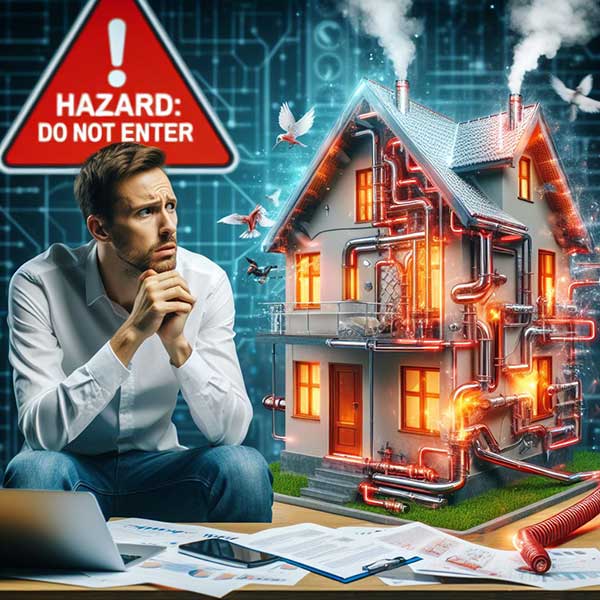Buying a new home is an exciting and joyful experience. However, the discovery of undisclosed environmental hazards can quickly turn that excitement into concern. Environmental hazards, such as lead-based paint, asbestos, mold, or contaminated soil, pose risks to the health and well-being of your family. While it can be distressing to find yourself in this situation, there are steps you can take to address these issues and create a safe living environment. In this blog, we will guide you through the process of dealing with undisclosed environmental hazards and help you protect your family’s health and safety.
1. Stay Calm and Gather Information
Discovering undisclosed environmental hazards in your new home can be overwhelming, but it’s important to stay calm and gather as much information as possible. Start by reviewing your purchase agreement, home inspection report, and any other relevant documents. Look for any clauses related to the disclosure of environmental hazards and contact your real estate agent or attorney to understand your rights and options.
2. Assess the Extent of the Environmental Hazards
Once you have gathered the necessary information, it’s time to assess the extent of the environmental hazards in your home. If you suspect the presence of lead-based paint, asbestos, or mold, consider hiring a certified professional to conduct a thorough inspection. They will be able to identify the hazards, determine their severity, and provide recommendations for remediation.
3. Consult with Experts
Consulting with experts who specialize in dealing with environmental hazards is crucial in this situation. Engage the services of professionals such as environmental consultants, remediation companies, and health inspectors. They have the knowledge and experience to assess the risks, develop mitigation plans, and provide guidance on how to address the hazards effectively.
4. Protect Your Family’s Health
While you work towards remediation, it’s important to take steps to protect your family’s health. If you suspect lead-based paint, ensure that any peeling or chipping paint is immediately addressed. Use wet cleaning methods to minimize the spread of dust and prevent exposure. In the case of mold, limit access to the affected areas and consider using air purifiers and dehumidifiers to reduce moisture levels.
5. Communicate with the Seller and Involved Parties
Contact the seller of the property and inform them about the undisclosed environmental hazards you discovered. Document all communication, including dates, times, and the nature of the conversation. Depending on the circumstances and the laws in your jurisdiction, you may be entitled to financial compensation or assistance with remediation costs. Consult with your attorney to understand your legal rights and options.
6. Explore Remediation Options
Work closely with the experts you have engaged to develop a remediation plan tailored to the specific environmental hazards in your home. Depending on the severity of the hazards, this may involve removing asbestos-containing materials, conducting mold remediation, or implementing measures to address soil contamination. Ensure that the remediation is carried out by qualified professionals to guarantee the effectiveness and safety of the process.
7. Inform Your Neighbors
If the environmental hazards in your home have the potential to affect neighboring properties, it’s essential to inform your neighbors about the situation. Open and honest communication can foster cooperation and prevent further spread of the hazards. Additionally, your neighbors may have valuable insights or experiences that can assist you in navigating this challenging situation.
8. Educate Yourself and Take Preventive Measures
While dealing with undisclosed environmental hazards can be distressing, it’s also an opportunity to educate yourself about environmental hazards and take preventive measures to ensure the safety of your family in the future. Stay informed about common environmental hazards, their signs, and preventive measures. Implement good maintenance practices, such as regular inspections for mold or lead-based paint, and promptly address any issues that arise.
9. Monitor Your Family’s Health
During and after the remediation process, it’s important to monitor the health of your family members closely. Keep an eye out for any symptoms or signs of exposure to environmental hazards, such as respiratory problems, allergies, or skin irritations. If you notice any unusual health issues, consult with a healthcare professional experienced in environmental health concerns.
10. Consider Legal Recourse
If the seller or other involved parties failed to disclose known environmental hazards in your home, you may have legal recourse. Consult with an attorney who specializes in real estate law to understand your options. They can guide you through the process of filing a legal claim, seeking compensation for damages, or negotiating a resolution with the responsible parties.
Discovering undisclosed environmental hazards in your new home can be alarming, but it’s important to take immediate action to protect your family’s health and safety. Stay informed, consult with experts, and address the hazards through remediation efforts. Communicate with the seller and consider legal recourse if necessary. By following these steps, you can ensure a safe living environment for your family and prevent future risks. Remember to stay proactive, educate yourself, and take preventive measures to safeguard your family’s well-being.
If you believe your home or business contains undisclosed environmental hazards that may pose hazards to your health, we can help. The technicians at Rarefied Air Environmental are experts at many types of environmental testing, including mold testing, asbestos testing, and lead paint testing. Contact us today to learn more about our full range of environmental testing services or to schedule an appointment.

